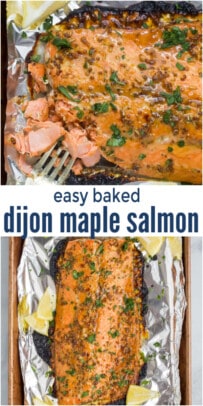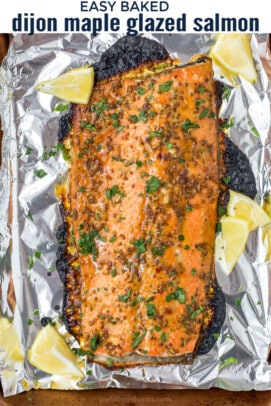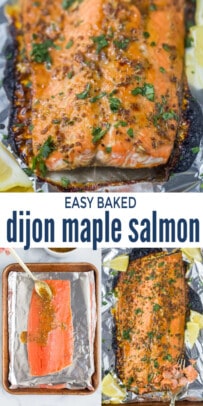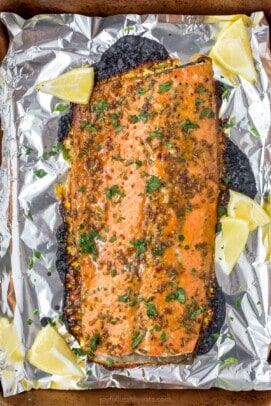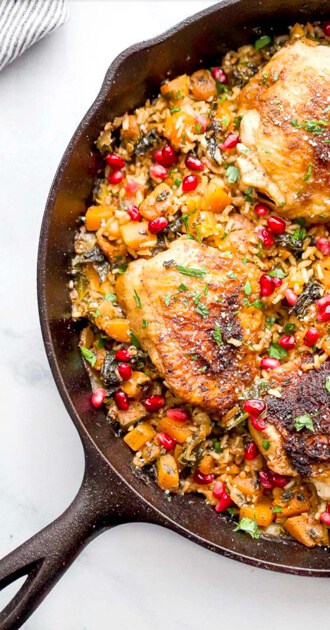Maple Glazed Salmon is a low-calorie, high-protein dinner that’s done in just 15 minutes! The tangy-sweet glaze caramelizes the skin of the fish while the inside bakes to tender perfection.
Swooning over this salmon dish? You’ll love my Easy Maple Dijon Air Fryer Salmon recipe, too!
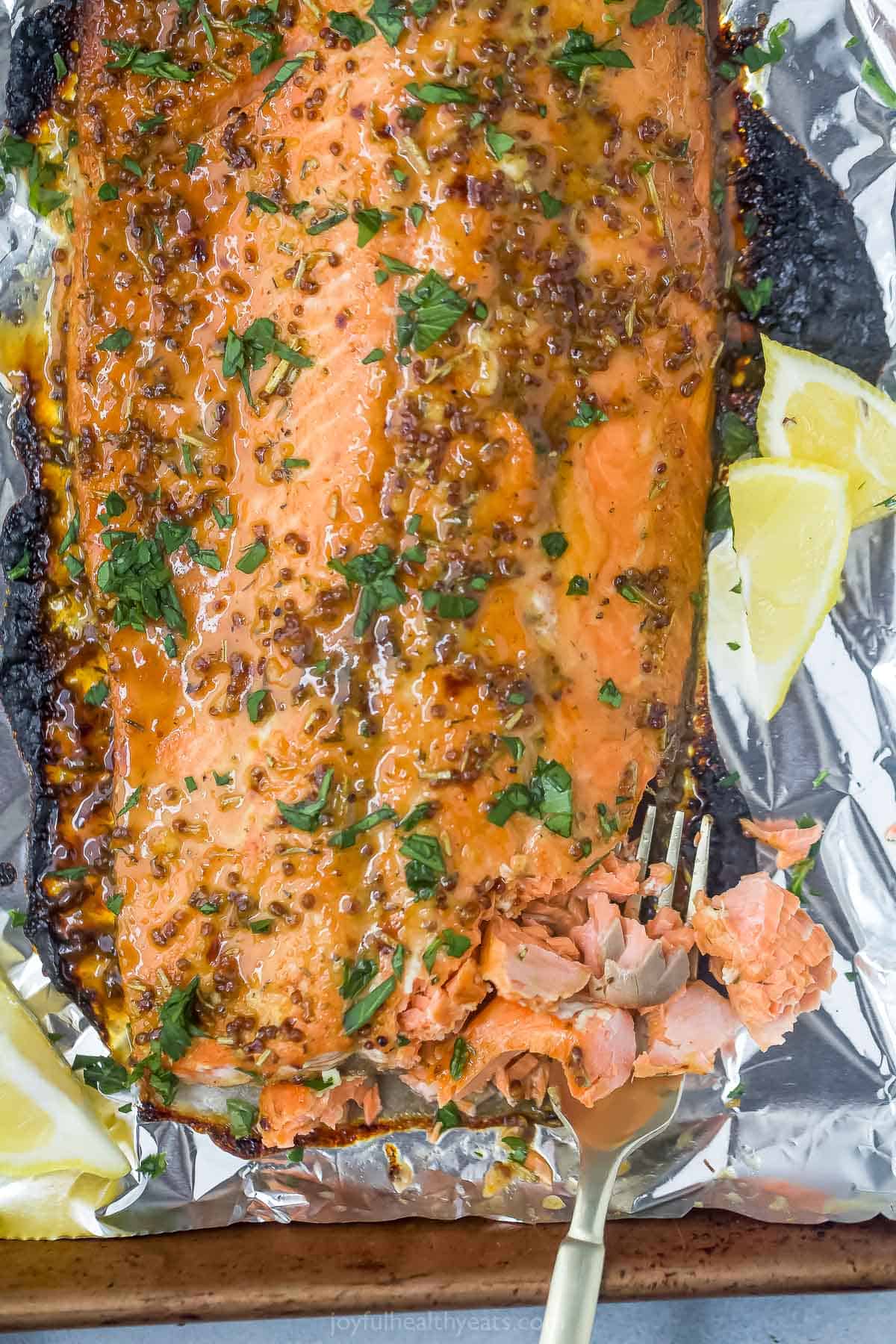
Flaky Maple Glazed Salmon Recipe
Have you ever had salmon so flaky and tender that it practically melts in your mouth? If not, you’re totally missing out. But don’t worry – this super simple recipe is about to remedy that.
Not only does this roasted salmon fillet have that meltingly delicious quality, but it’s also coated in the most incredible Dijon maple glaze. It has a tangy, sweet, and herbaceous flavor that goes so well with the taste of the fish. The glaze also gives the exterior of the salmon a crispy caramelized crust.
One of the best things about this hearty main course is that it comes together super quickly. That, and the fact that it’s so nutritious! Salmon is naturally low in saturated fat and rich in protein, vitamins, potassium, and iron.
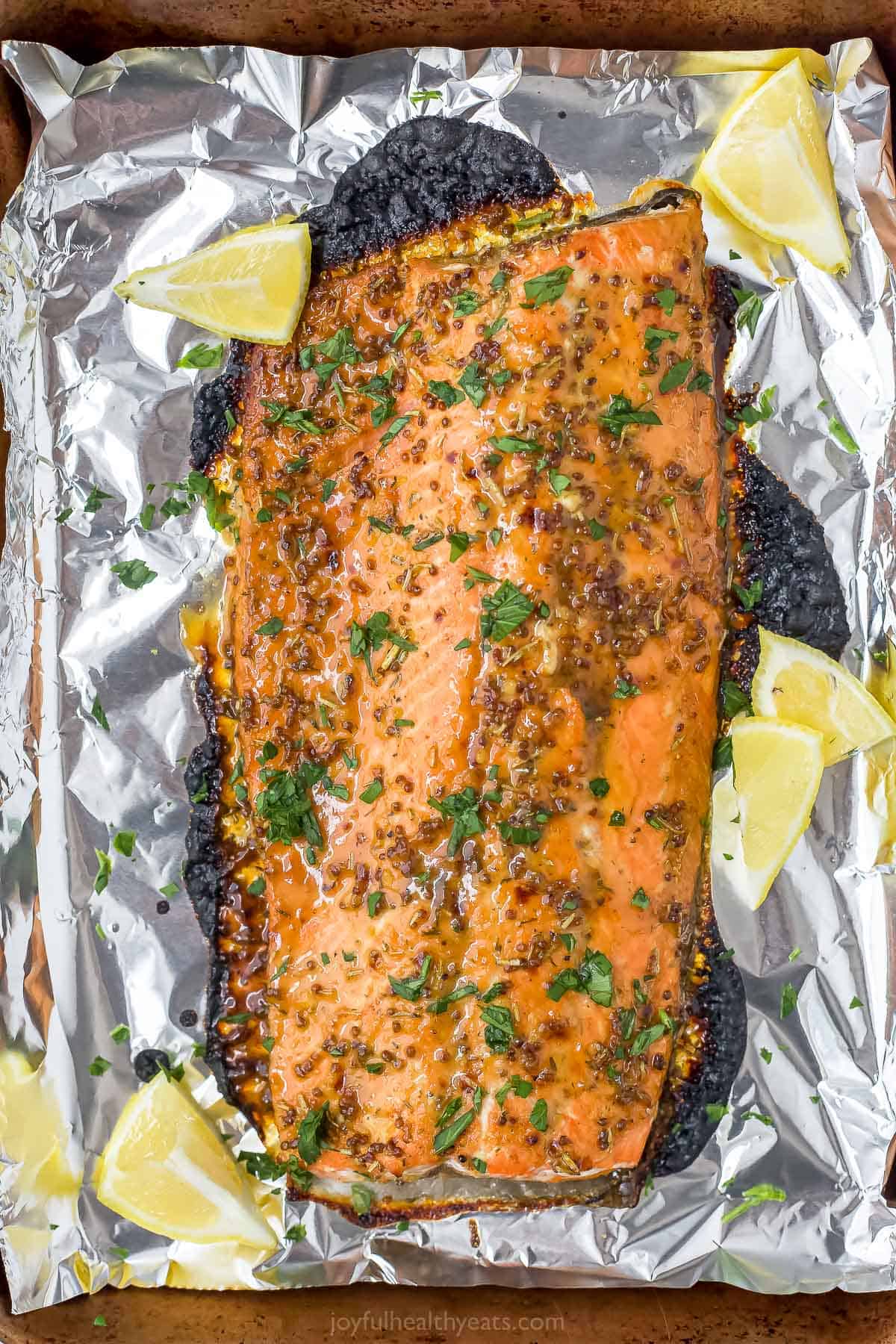
Why You’ll Love This Maple Salmon Recipe
I’m a big fan of salmon because there are so many ways to make it! That said, here’s why I think you’ll love this maple and mustard version:
- Sweet and savory. This tender salmon is bursting with flavor! Sugary maple syrup and tangy Dijon mustard create a bold, sweet and savory glaze that you definitely don’t want to miss out on.
- Quick and easy. Maple glazed salmon comes together in just 15 minutes! So, when life gets hectic and you need something quick, simple, and filling for dinner, this recipe is perfect.
- Perfect texture: On the interior, this baked salmon is super flaky and tender, but the exterior gets nice and crispy thanks to the broiler. So good!
What You’ll Need
You only need a handful of ingredients to throw together this maple glazed salmon. Here they are! If you’re looking for exact ingredient amounts, you can find them in the recipe card below.
- Fresh Salmon Fillet: Try to pick out a brightly-colored, moist-looking fillet. Also, I always recommend purchasing wild-caught salmon rather than farm-raised salmon. The meat not only has a better flavor, but it’s also leaner and therefore healthier.
- Coarse Ground Mustard: This chunky condiment has a deep flavor that supplements the tanginess of the Dijon mustard.
- Dijon Mustard: You can also use yellow mustard in a pinch. The flavor is milder but still tangy and delicious!
- Maple Syrup: Be sure to use pure maple syrup rather than an articifial alternative.
- Garlic: Freshly minced garlic produces the strongest, boldest flavor.
- Thyme & Rosemary: These add earthy and citrusy flavors.
- Smoked Paprika: For a nice kick of heat. If you’re not a fan of spice, feel free to leave it out or reduce the quantity used.
- Salt & Pepper: Added to taste.
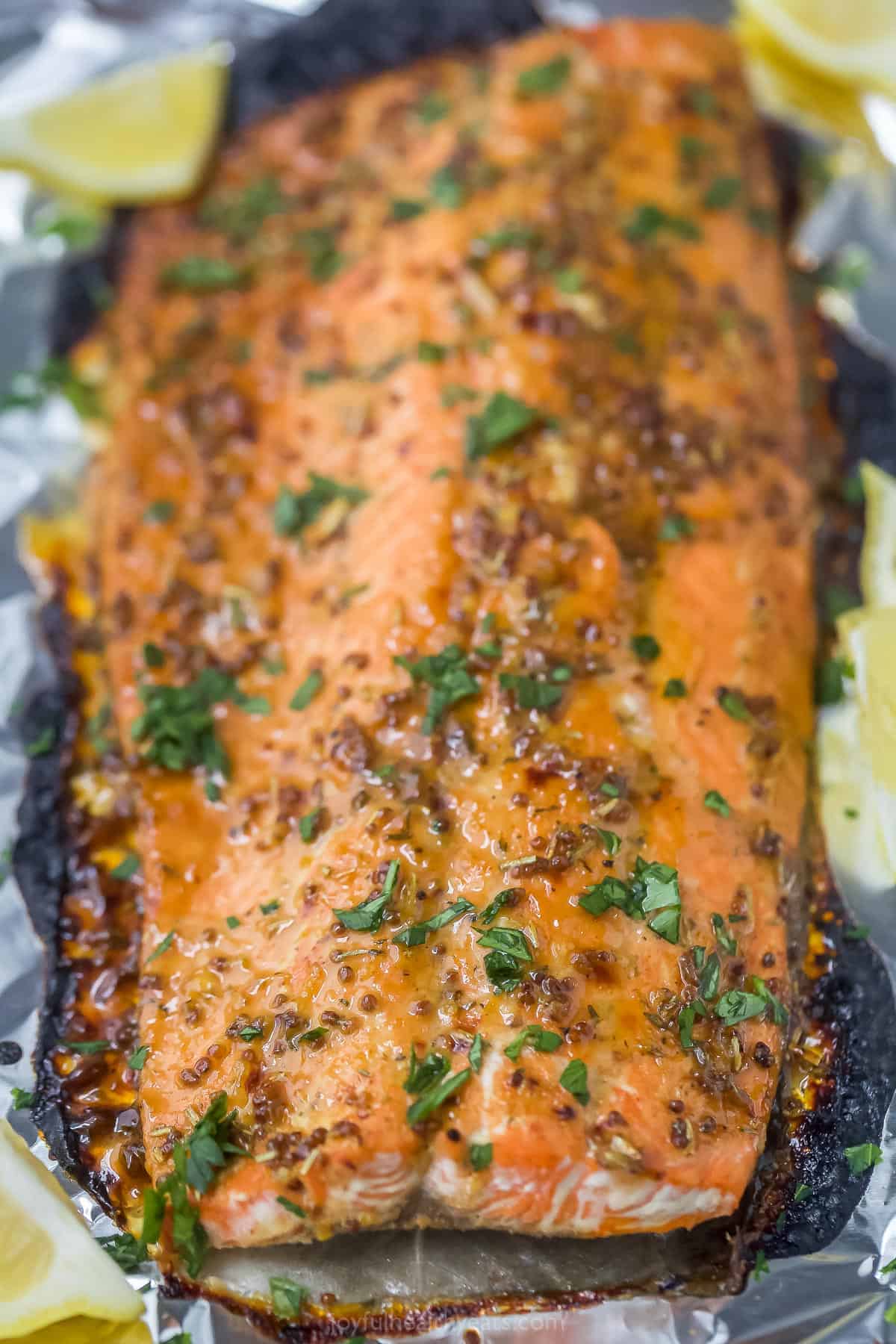
How to Make Maple Glazed Salmon
A lot of people seem to like grilled salmon better than baked salmon – but I’m definitely not one of them. Baking the fish as opposed to grilling it ensures that the entire fillet cooks at an even pace for flakiness all around. Plus, you can get that same crispy skin with the help of the broil function.
Follow these easy steps to see how it’s done! (You can find the full set of directions for maple salmon in the recipe card below, as well.)
- Heat the oven. Preheat the oven to 400°F.
- Pat the fillet dry. Use a paper towel to pat the salmon fillet dry.
- Place the fish onto a lined baking sheet. Line a baking sheet with tin foil and place the dried fillet onto the covered baking sheet.
- Prepare the glaze. Whisk together the remaining ingredients in a small bowl until the glaze is smooth.
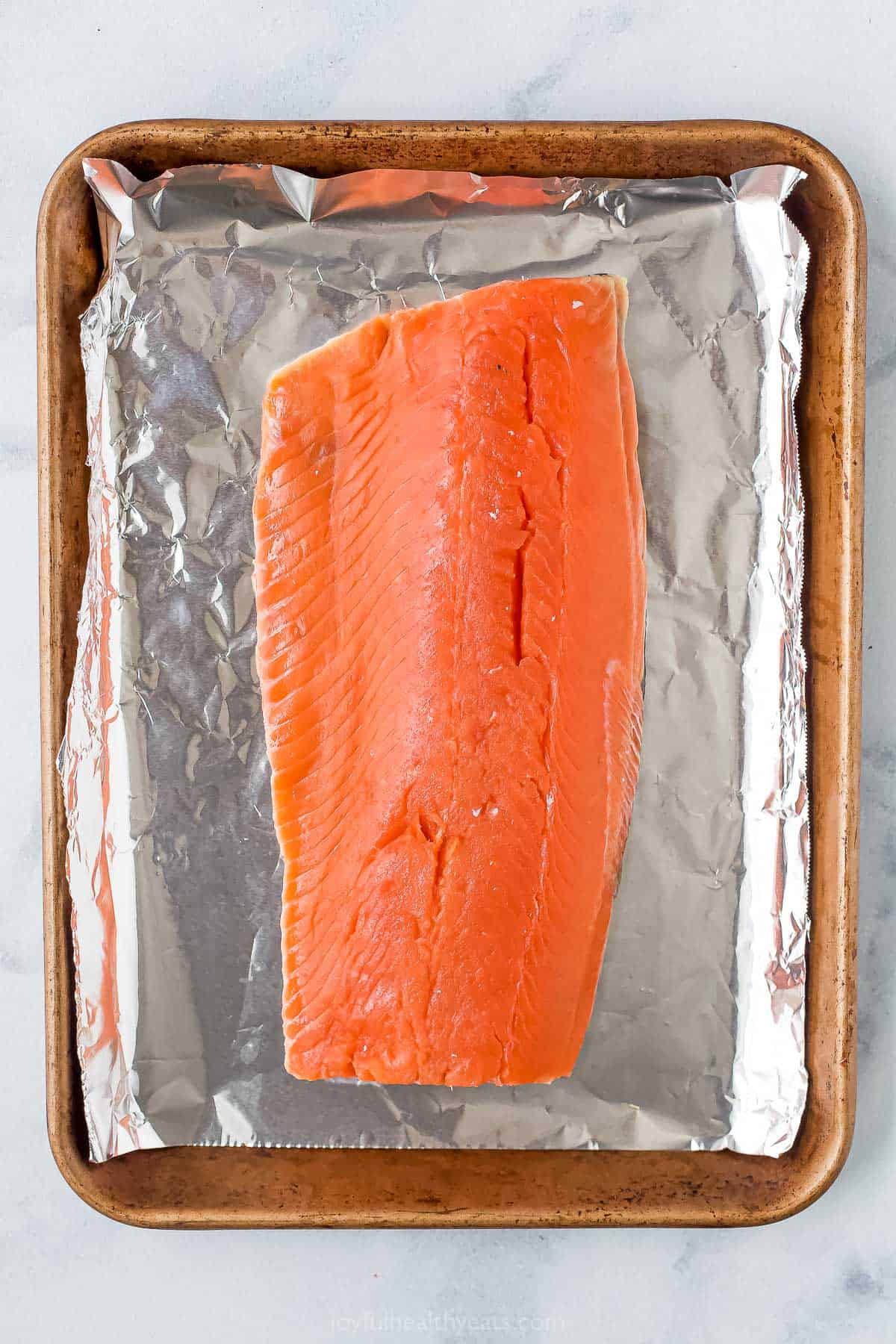
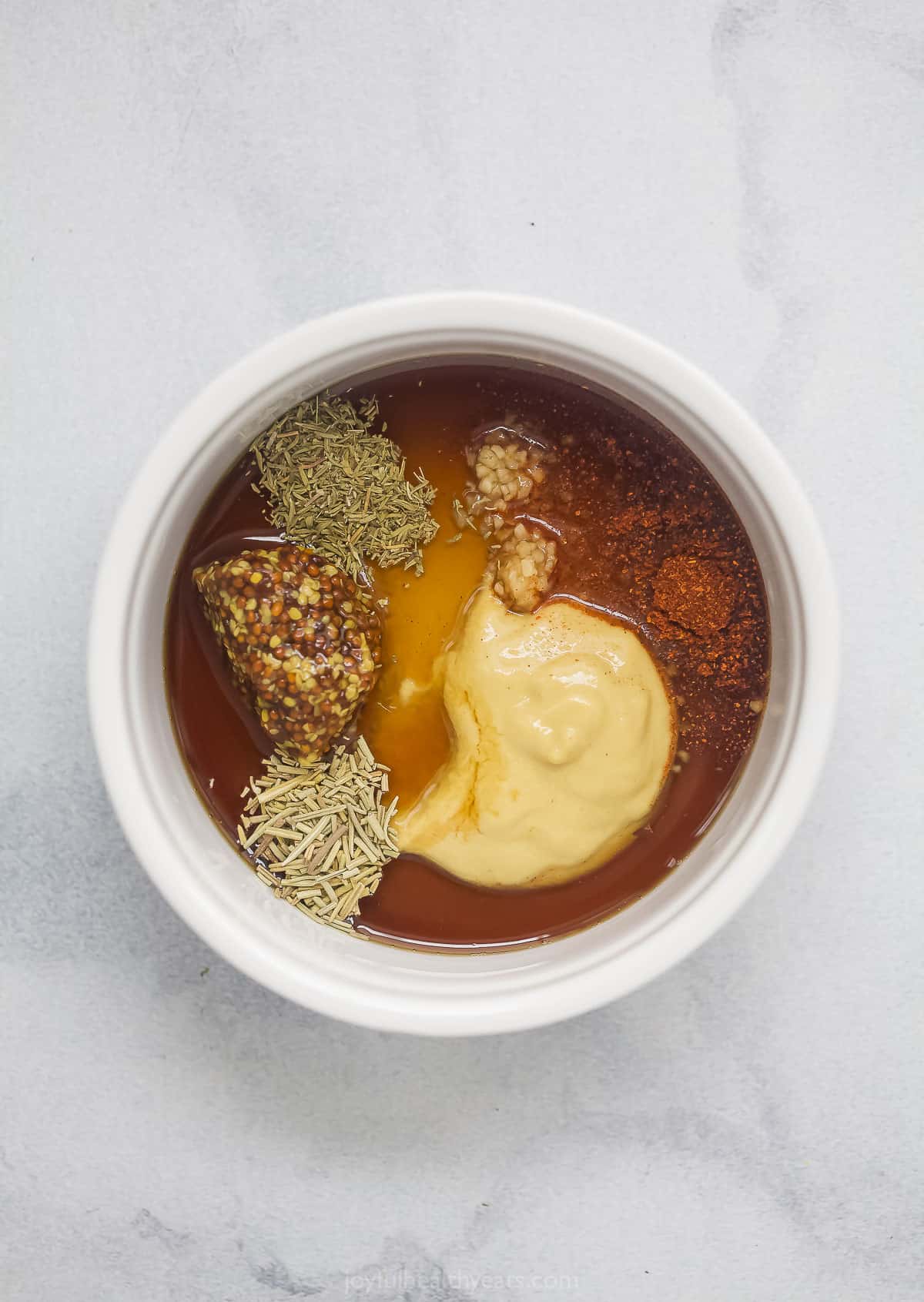
- Brush the glaze onto the salmon. Brush the prepared glaze onto the salmon fillet, reserving a small amount for a second round of glaze post-baking.
- Bake. Bake the salmon for 8 minutes.
- Broil. Remove your salmon fillet from the oven and turn on the broiler. Then, place the salmon back under the broiler for 2 minutes, until it’s no longer pink and flakes off with a fork.
- Glaze the salmon again. Brush the reserved glaze onto the finished fillet, then cut and serve it.
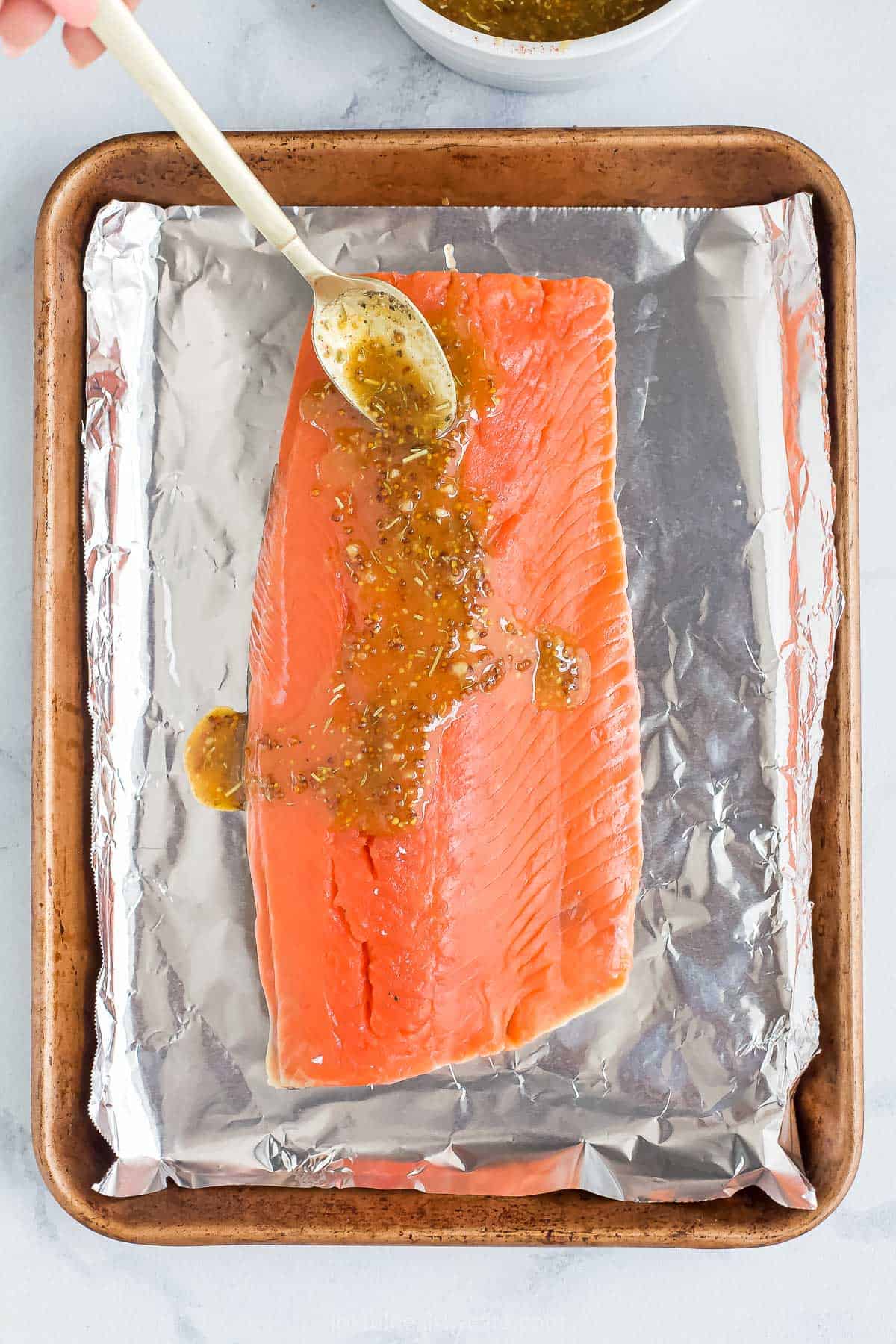
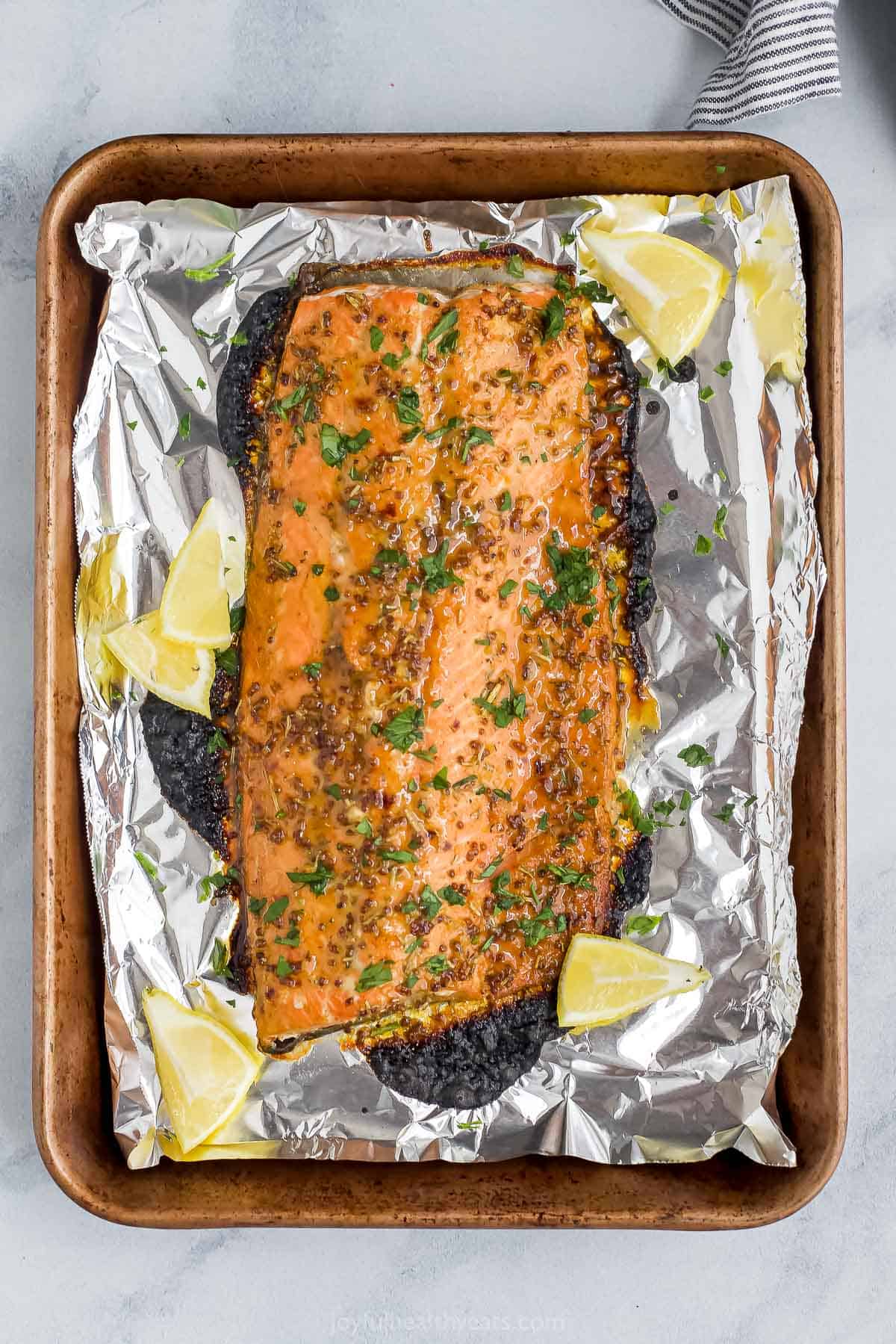
How Do I Know When My Salmon is Done?
Once your salmon fillet turns from dark pink to a light pinkish-orange, remove it from the oven. You can test it for doneness by gently pressing down on it with a fork. If the salmon flakes off with the fork, it’s ready to eat.
Tips for Success
Get familiar with the tips and tricks below so you can make a flawless Dijon maple glazed salmon fillet on your first try.
- Use skin-on salmon. Cooking salmon with the skin on allows it to stay nice and moist. You can use skinless salmon if you like, but it is more likely to dry out while cooking.
- Season to taste. Feel free to add more of any seasoning to your glaze depending on your palate. If desired, you can always sprinkle on some extra salt, pepper, herbs, paprika, or garlic at the end.
- Check the internal temperature. If you really want to make sure your salmon is cooked to perfection, use a meat thermometer to check its internal temperature. It should register at 125°F.
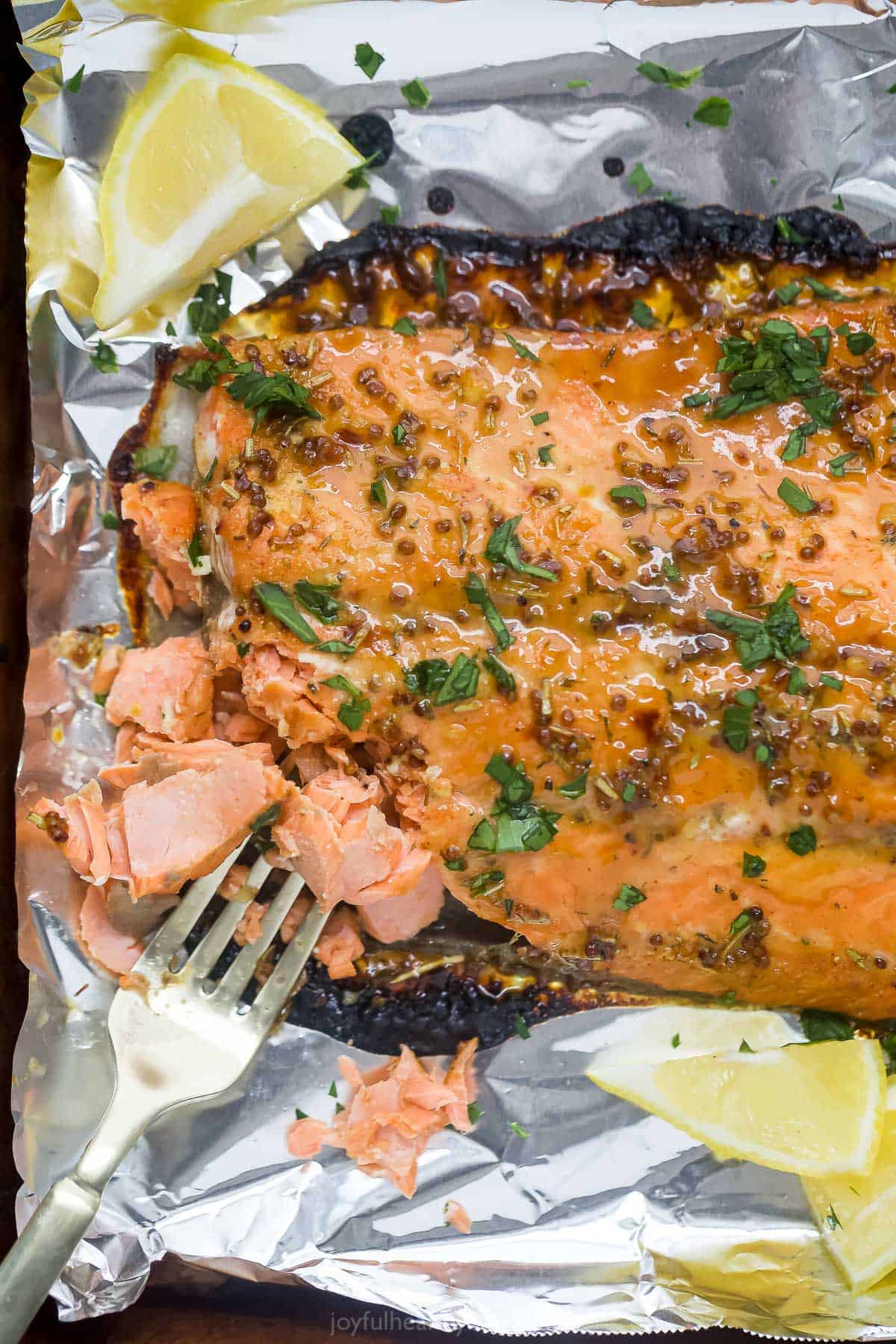
Frequently Asked Questions
I like to bake this salmon at 400°F because the skin gets a little crispier and it’s quicker. But, if you’re cooking salmon with veggies in the same pan, you may want to try 350°F to give the vegetables more time to roast.
Uncovered is just fine! The salmon will still come out perfectly moist and tender, and with crispy skin, too. Covering it will prevent that exterior layer from becoming crispy.
Overcooking salmon is the most common reason that it comes out dry. If you’re worried about this, check on the salmon at 6 or 7 minutes and test to see if the internal temperature has already reached 125°F.
Serving Suggestions
Need a stellar side to pair with your maple glazed salmon? Try one of the following dishes.
- Serve with brussels sprouts. These Crispy Garlic Parmesan Air Fryer Brussels Sprouts are a game-changer. Flavored with garlic powder, salt, pepper and grated parmesan cheese, they taste incredible alongside this roasted salmon.
- Pair with cilantro lime rice. You truly can’t go wrong when you serve this salmon beside a steaming bowl of Cilantro Lime Rice. Such a crave-worthy combination!
- Serve with asparagus fries. Flaky maple salmon with a side of Crispy Asparagus Fries? Yes, please! A healthy alternative to classic french fries, they conveniently bake at the same temperature as the salmon.
- Pair with garlic lemon pasta. I can’t say enough good things about this Light & Easy Garlic Lemon Pasta. It’s a satisfying 15-minute dish that goes great with this sweet and tangy salmon.
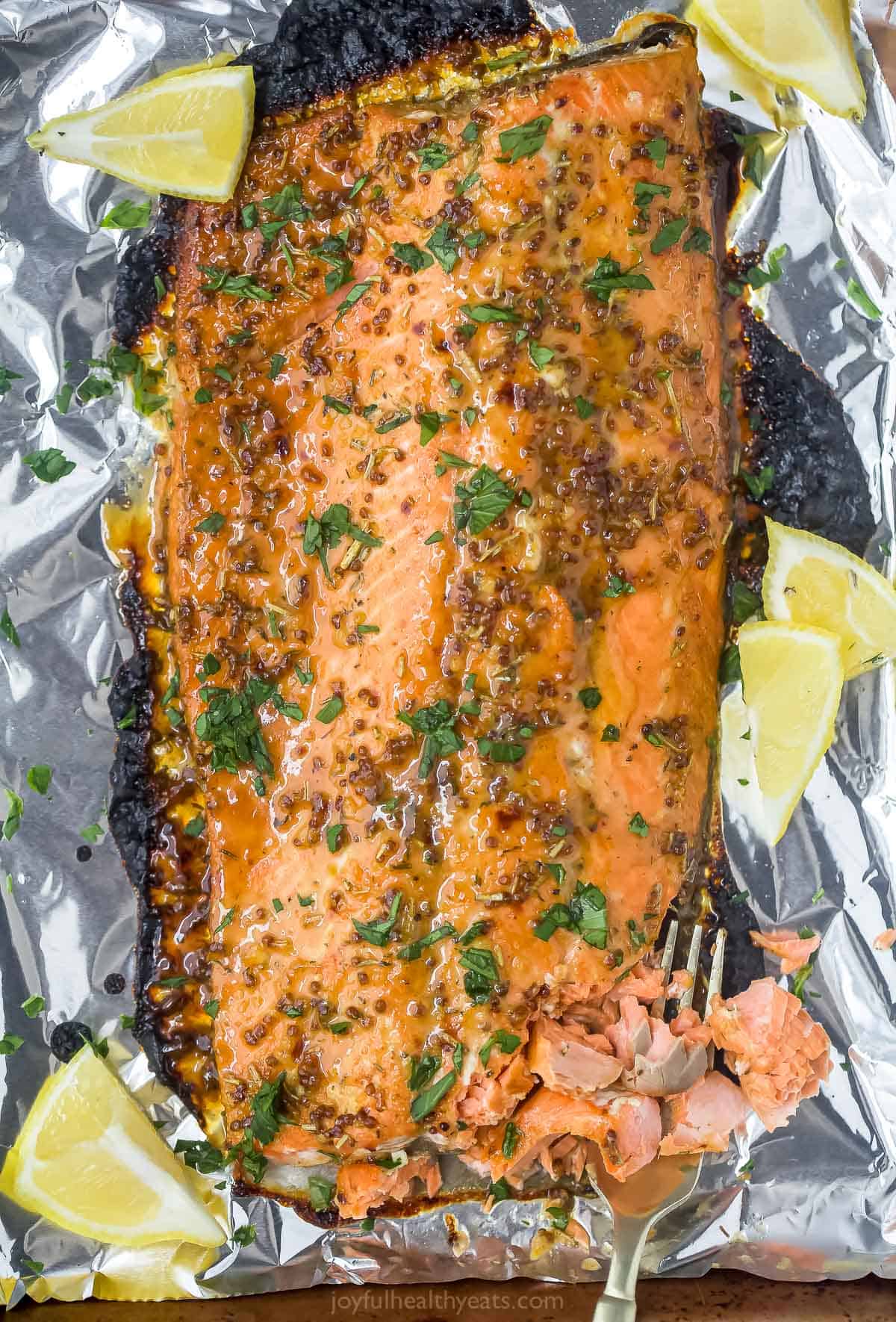
Storing and Reheating Leftovers
Once it has cooled completely, place any leftover Dijon maple glazed salmon into an airtight container and store it in the fridge. Enjoy it within 2-3 days of making it.
To reheat your salmon, simply wrap it in aluminum foil to lock in the moisture and place it in a 325°F oven for about 5 minutes. Alternatively, you can cut up your salmon and enjoy it cold on top of a salad.
Can I Freeze Baked Salmon?
Yes! You can freeze the cooled salmon in an airtight container for up to 3 months. Make sure to let it thaw out in the fridge before reheating and/or enjoying it.
More Simple Salmon Recipes
In the mood to chow down on some more tender salmon? I have just what you need!
- Salmon Cakes With Lemon Dill Yogurt Sauce
- Easy Salmon Tacos With Creamy Slaw
- Grilled Lemon Pepper Salmon
- Honey Garlic Air Fryer Salmon
- 20 Minute Air Fryer Pesto Salmon
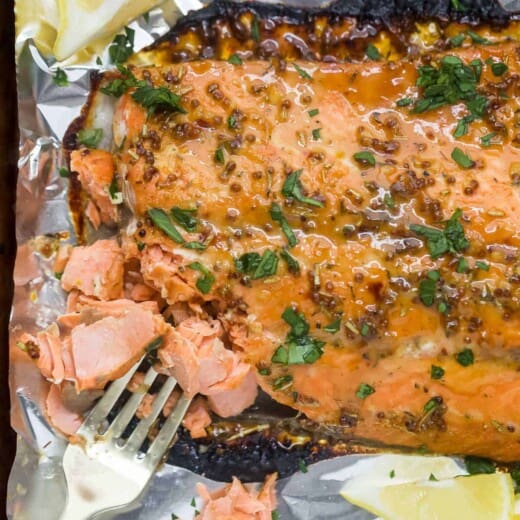
Maple Glazed Salmon
- Prep Time: 5 minutes
- Cook Time: 10 minutes
- Total Time: 15 minutes
- Yield: 5 1x
- Category: Dinner
- Method: Oven
- Cuisine: American
Description
Dijon Maple Glazed Salmon takes 15 minutes to make, and requires only a handful of simple ingredients! The tangy-sweet glaze caramelizes the skin of the fish, while the interior is perfectly flaky and tender.
Ingredients
- 1.5 pounds fresh salmon fillet
- 1/2 tablespoon coarse ground mustard
- 1 tablespoon dijon mustard
- 2 tablespoons pure maple syrup
- 1 garlic, minced
- 1/4 teaspoon thyme
- 1/4 teaspoon rosemary
- 1/8 teaspoon smoked paprika
- salt & pepper to taste
Instructions
- Preheat oven to 400°F.
- Pat salmon dry using a paper towel.
- Cover a baking sheet with tin foil.
- Place salmon on covered baking sheet.
- In a small bowl mix mustard, dijon mustard, maple syrup, garlic, thyme, rosemary, smoked paprika, salt, and pepper. Whisk until smooth.
- Brush the mustard maple mixture on salmon, reserved a small amount for glazing later.
- Bake salmon for 8 minutes.
- Remove from oven. Turn broiler on.
- Place salmon back under broiler for 2 minutes until no longer pink and salmon flakes with a fork.
- Brush with remaining glaze and serve.
Notes
- Yield: Makes 4-6 servings.
- To Store & Reheat: Place cooled salmon into an airtight container and refrigerate for 2-3 days. To reheat, wrap salmon in aluminum foil to lock in moisture and place in a 325°F oven for about 5 minutes. Alternatively, cut up cold salmon and serve over salad.
- To Freeze: Freeze cooled salmon in an airtight container for up to 3 months. Thaw in the fridge before reheating and/or enjoying.
Nutrition
- Serving Size: 4 oz.
- Calories: 180
- Sugar: 4 g
- Sodium: 386 mg
- Fat: 6 g
- Saturated Fat: 1 g
- Carbohydrates: 5 g
- Fiber: 0 g
- Protein: 22 g
- Cholesterol: 28 mg
Filed Under:
DON’T MISS A RECIPE
FACEBOOK | TWITTER | PINTEREST | BLOGLOVIN | INSTAGRAM

